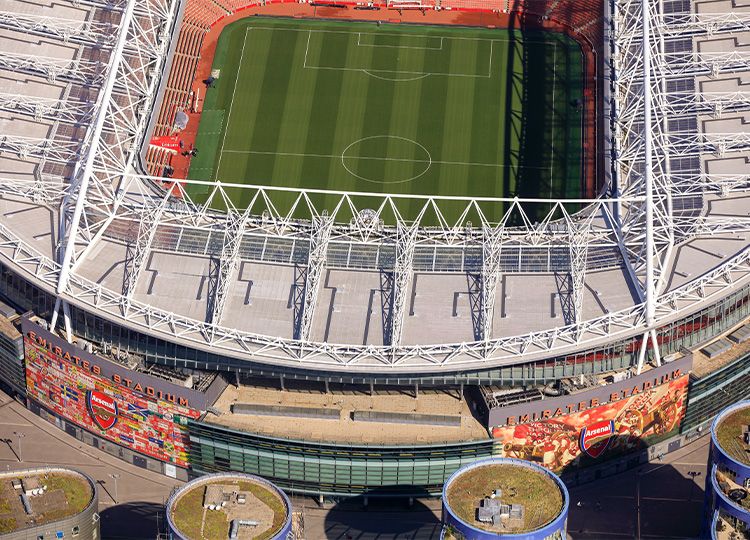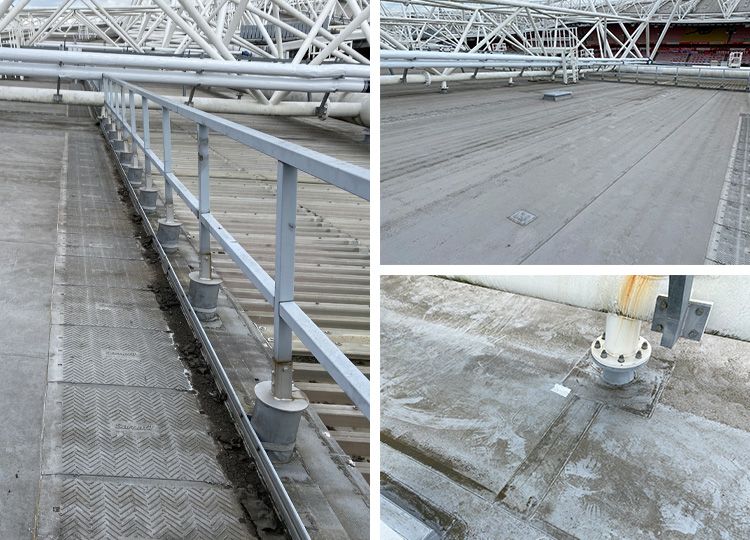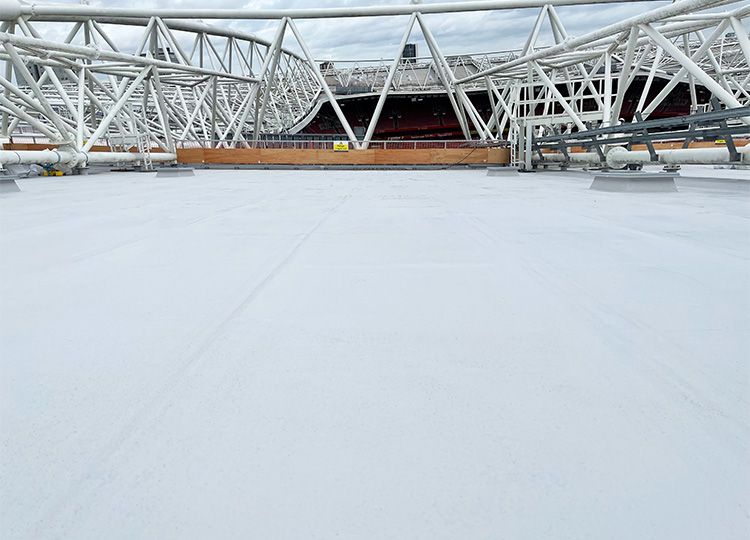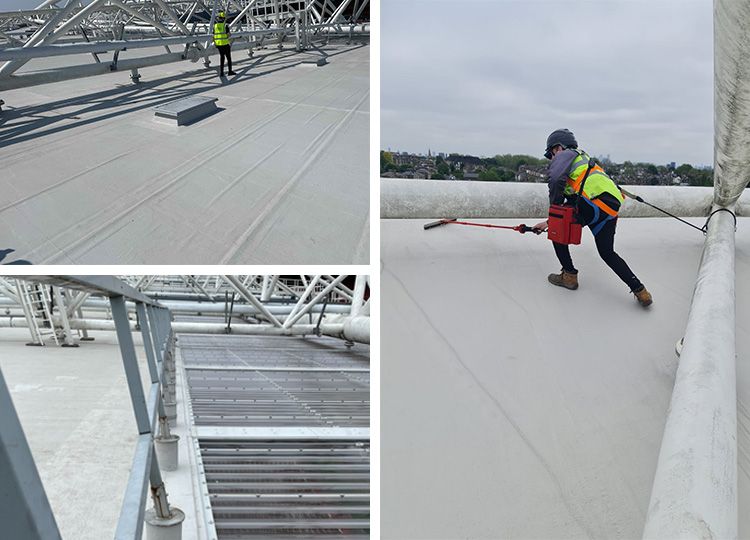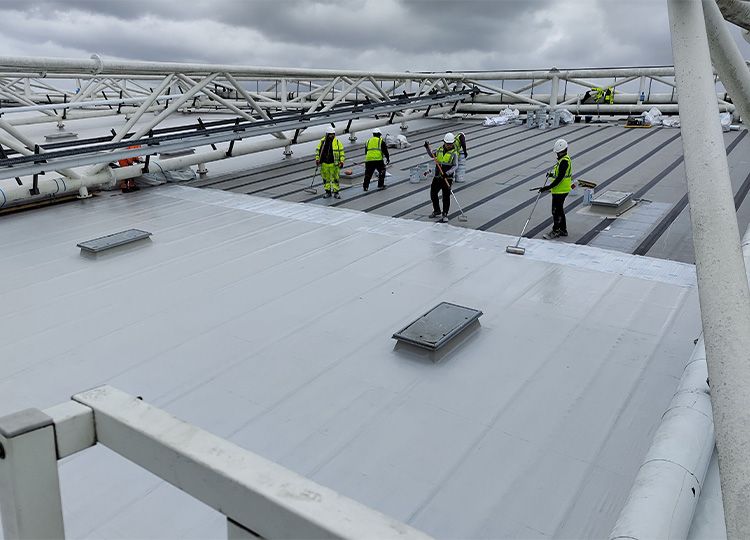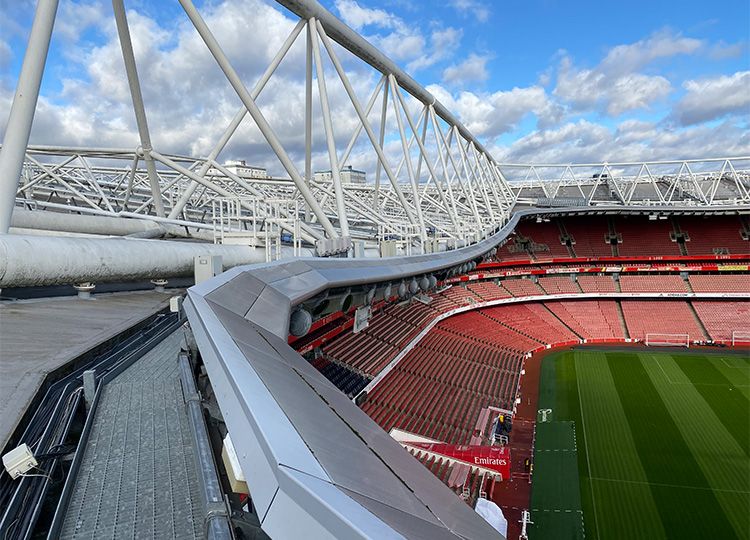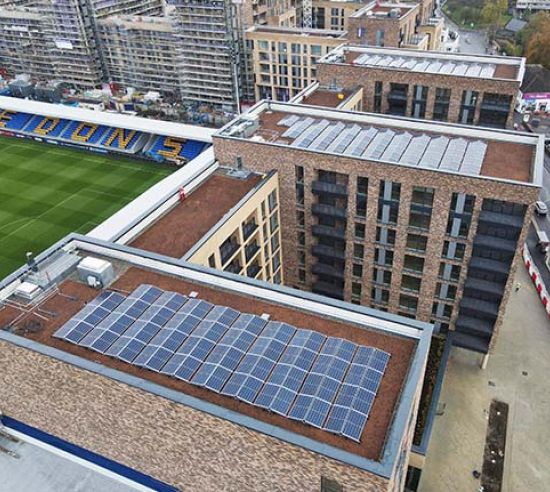Introduction
The Emirates Stadium’s 27,000m2 roof is supported by four gigantic steel trusses, which in turn support a series of secondary and tertiary steel beams. The complicated geometry results in a gently sloping elliptical bowl shape, with polycarbonate panelled roof areas designed to maximise sight lines for spectators.
Completed in 2007, the original single ply and polycarbonate sheet roof were failing in areas resulting in water ingress. With a 60,000 capacity, not only does the stadium play host to world class football, but also concerts and other events. The leaking roof was a high priority as part of the owner’s refurbishment plans.
The challenge
The roof refurbishment needed to fit around the many fixtures of the season. A waterproofing solution was sought that could offer minimal disruption and could overlay the existing single ply membrane.
Working with Triflex Authorised Contractor, Topek Southern Limited (TSL), the Triflex Technical Team undertook a detailed survey to establish the current state of the roof, confirm build-up and undertake a range of tests to identify the best solution for the Emirates Stadium roof. The stadium roof build-up was confirmed to consist of a profile metal deck with plywood and PVC single ply membrane. Evidence of splits at laps and other surface damage was apparent. A partially bonded walkway matting was also originally installed on the surface of the existing single ply membrane for access and maintenance purposes.
The solution
A bespoke solution backed by science
The in-depth evaluation included the extraction of several samples of the existing single ply waterproofing membrane, to test for plasticiser migration at the Triflex laboratories in Germany. Plasticisers were historically added to some compositions of single ply membranes to enhance their flexibility. These plasticisers can migrate out due to heat, age or under certain chemical conditions, leaving single ply membranes brittle and prone to damage. Triflex take a scientific approach to ensure that the existing membrane can be overlaid with confidence. The testing of the Triflex ProTect system with the single ply membrane samples confirmed that the proposed Triflex liquid applied membrane overlay solution was compatible.
Adhesion tests were also carried out in situ on the existing single ply membrane to confirm any pretreatment or primer requirement. The Triflex ProTect PMMA based system achieved very strong adhesion with only a simple cleaning step required, providing a simple and effective overlay solution.
The resulting bespoke project specification proposed the proven Triflex ProTect system. The complex form of the stadium roof means that there were extensive numbers of details where the steels support the roof, together with multiple detail types such as access hatches and services. The reinforced liquid applied membrane could easily accommodate the complex forms. With elastomeric properties, the system can cope with the various coefficients of variation and thermal properties of the different substrates it overlaid.
Repairs or mechanical re-fixing of the single ply was completed prior to the installation of the liquid membrane, facilitated by PMMA based repair materials that cured in less than 60 minutes.
At the interface with the polycarbonate sheets the liquid applied membrane self-terminated onto metal flashing, providing a robust interface. The partially bonded walkway was removed and replaced with a tough and durable liquid applied walkway solution with high anti-skid finish. This was achieved through the incorporation of beads into the liquid resin prior to application, rather than the conventional casting of quartz into the installed wet finish. This avoided the risk of cast quartz entering the drainage channels and any resulting blockages. The new, contrasting colour provided a more visible and defined walkway increasing safety for maintenance personnel.
Adverse weather during the project provided challenges too for the schedule of works. The Triflex ProTect system can be installed onto substrates between 0°C and 35°C, and rapidly cures even in winter temperatures reducing the impact on project timescales.
Meeting the challenges of a live stadium
During the project some 29 fixtures required accommodation, more than the original planned number accounted for in the works programme. The live stadium environment dictated that a full handover of the roof was required prior to each event, vacating the roof some 48 hours before each event. The TSL installation team and project managers demonstrated skillful management of the challenges associated with frequent full roof handovers. They implemented a controlled approach to the installation of roof sections to effectively manage the program of works for the live site.
The complex stadium roof design meant there were many roof penetrations and details to consider in each section including posts, hatches, vents, cable trays, ladders and utility points. The multiple vulnerable details and penetrations were waterproofed with the liquid Triflex ProDetail reinforced system. The live site meant that the installation area needed to be temporarily (in the case of polycarbonate sheets) or permanently watertight at the end of each day.
With the Triflex PMMA waterproofing systems rapidly curing, permanent waterproofing could be completed at both the extensive number of post details and section of single ply overlay to provide a time dependable installation. The Triflex liquid applied systems were installed to a high standard as borne out by the leak detection undertaken as each section was completed. The Triflex authorised contractors are highly trained and supported by the Triflex Technical Team.
TSL expertly managed the agile works. To ensure on time delivery, they were able to resequence works or increase the workforce as required. The Triflex Technical Team continued to support with on-site visits providing reassurance and advice to the installation team, safeguarding continued high quality installation in a changing schedule and workforce resource.
A comprehensive approach to safety
Working at such height and exposure to high winds for this type of structure required additional risk management consideration by TSL. With a sheer drop-off at the edge of the roof, conventional scaffolding was not feasible. Consequently, alternative edging and safety precautions were implemented. A leading-edge safety system was installed, spanning from steel to steel, utilising the eyes on the steels. As well as safety harnesses, nets were used around the polycarbonate areas to ensure optimum safety for a labourers, alongside boards placed across steels. In addition, materials were secured each day and all tools were removed prior to events too, reducing the risk for falling debris at the live site.
The nature of the stadium roof meant that structural load management was carefully considered. Every material distribution phase was closely monitored by structural engineers to ensure that the roof's integrity was not compromised. This involved the strict adherence to predetermined weight limits and securing materials to secondary steel structures for added stability, ably undertaken by the team.
Helping meet sustainability goals
The logistics of getting materials onto the roof were challenging due to the very few access points around the stadium. A crane was used for all lifting, the use of which was dependent on wind speeds in what was a wet and windy summer. The crane used was an electric hybrid crane, fitting with the Emirates Stadium sustainability goals.
The refurbishment of the roof with a liquid applied membrane overlay solution negated any strip up. The existing single ply membrane was left in situ, meaning that there was no costly removal or disposal required, which can be challenging at such a height.
The Emirates Stadium roof is now watertight and fans are able to enjoy the match or concert in comfort.

